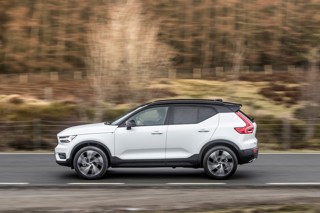Gaps in vehicle CO2 data held by leasing companies are causing a headache for fleets with less than two months to go before emissions results from the new WLTP test start being used for tax purposes.
Many manufacturers, including Mercedes-Benz, BMW and Volkswagen Group, have published CO2 values derived from the new test, but others have yet to reveal their full results.
One leasing company suggested it only had the new CO2 data for 75% of the cars it offered, while trade association the British Vehicle Rental and Leasing Association (BVRLA) says members only have data for around 80% of base (pre-option) models.
Fleet News understands that several manufacturers have supplied less than a third of their emissions data.
It means some fleets and company car drivers are ordering vehicles now with no way of knowing exactly how much tax they could pay until their car is registered.
Leasing companies, which typically receive the CO2 data from third-party providers, are estimating emissions for vehicles in some cases or trying to bring forward deliveries to ensure they are registered before April.
“It’s really challenging,” said Nick Hardy, sales and marketing director at Ogilvie Fleet. “We’ve got some (CO2 data), but we haven’t got all the data we need.”
He said Ogilvie Fleet has tried to identify those vehicles on order “most at risk” of seeing an increase in CO2, under the new emissions testing regime, and trying to bring the delivery forward. However, he said: “You can’t do that in every case.”
‘NO CONDITIONS’ ON CO2 DATA
The Worldwide Harmonised Light Vehicle Test Procedure (WLTP) laboratory test, used to measure fuel consumption and CO2 emissions, was introduced for all new cars from September 2018.
The new CO2 rating derived from the test will be used to determine vehicle excise duty (VED) from April 1 and company car tax calculations for vehicles registered from April 6.
Manufacturers have been compelled to provide fuel economy figures based on the WLTP test from January 2019, but no similar conditions were placed on the CO2 data.
Instead, manufacturers have been left to publish the new emissions values at their own choosing.
Mike Coulton, EV consultant at VWFS Fleet, told Fleet News: “Ideally, it would have been mandated by Government that WLTP CO2 emissions were published alongside WLTP fuel economy and NEDC-correlated emissions figures long before April 6, 2020.
This would, he said, “allow for lead times on orders and help fleets and their drivers make informed company car choices”.
With April fast approaching, David Bushnell, principal consultant at Alphabet GB, believes it is now vital manufacturers provide all the data “as soon as possible”.
He says that the absence of some CO2 data “has been difficult and remains difficult” for the leasing industry.
He continued: “It’s widely understood that WLTP is around a 10-20% increase on correlated (NEDC CO2 values) and you can take a best guess on where they are going to be.”
However, he said: “It astounds me that we have got to this stage and they (manufacturers) are still reticent to publish some of the results.”
Like Ogilvie Fleet, Alphabet is trying to bring forward deliveries where possible. “Anything we can get delivered before (April), we’re trying to bring forward,” said Bushnell.
“We’re having to look at our order bank; work with the manufacturers to nail down a delivery date and liaise with the driver. We’re looking at it on a driver-by-driver, order-by-order basis.”
The country’s biggest vehicle leasing company, Lex Autolease, said it was keeping drivers and fleets with vehicles on order informed of any potential changes.
Chris Chandler, principal consultant at Lex Autolease, explained: “Where vehicle quotes have been based on NEDC data, but delivery won’t be until after April 6, we are revising quotes and explaining the cost implications to customers, keeping them fully informed throughout the quote-to-delivery process.”
However, he added: “It has been challenging to get the emissions data required from OEMs. This is an industry-wide issue – we’re working hard to ensure we’re in the best possible position for our customers by April 6.”
VWFS Fleet says each quote and subsequent order it receives includes a disclaimer that highlights the potential impact of WLTP and associated timings.
Coulton added: “Our WLTP pull-forward proposition also offers customers advice on a quote-by-quote basis, including early termination fees and various options to minimise the cost impact associated, allowing customers to order and bring forward their delivery.”
Mike Hawes, chief executive of the Society of Motor Manufacturers and Traders (SMMT), said that due to the complexity of the data “a single standard industry approach to the supply of WLTP CO2 values to fleets is no longer possible”.
He added: “Each manufacturer will have its own commercial arrangements to facilitate data sharing and will be working with stakeholders, including leasing companies, to determine bespoke solutions. An individual customer wishing to purchase a vehicle can obtain the necessary data direct from the relevant manufacturer.”
Jaguar and Hyundai are among some of those manufacturers that have yet to publish WLTP CO2 values.
GOVERNMENT GUIDANCE
Hyundai told Fleet News it intends to publish its WLTP CO2 data on April 1, in line with “Government guidance”, while Jaguar said that the release of its data would be “timely with the April changes” but could not give a specific publication date.
Henry Williams, head of fleet at Škoda, which published results for its vehicles in October 2019, said it was “incredible” some manufacturers have yet to release all their WLTP CO2 data.
He said: “If you’re a leasing company (not having the data) gives you quite a substantial problem, because you have cars on order that you don’t know what the CO2 values for those cars will be if they’re delivered post April 6.
“We’re really conscious that we don’t want to let customers down, which is why we come out as early as we can with things like this that could potentially affect a customer’s tax bill or, for the leasing company, VED rate as well.”
He continued: “It’s not fair to the end user if they get a car arrive on April 7, that has a BIK tax bill for the driver of x% more than they thought they were going to pay.”
The BVRLA is urging companies to review their fleet policies now, because of the gaps in data.
BVRLA chief executive Gerry Keaney said: “The introduction of WLTP-based motoring taxes is adding yet another layer of complexity and confusion to a fleet sector that is already having to cope with a deluge of new automotive technology and local authority air quality measures.
“The BVRLA and its members are working with OEMs and third-party data providers to bridge this gap, but in the meantime, we would recommend customers consult their lease providers to assess the impact on fleet policies and procurement.”
IT SYSTEMS UPDATED
The challenge of leasing companies having timely access to all the vehicle emissions data has been matched by the industry’s need to adapt its systems to meet the new benefit-in-kind (BIK) tax tables.
Industry-wide, millions of pounds have been spent upgrading software in readiness for the new regime and, while leasing companies are appealing for gaps in the data to be addressed quickly, their IT systems, they say, are ready for the new regime.
Chandler explained: “The most complex part of the transition to WLTP is the testing of accessories and the near-infinite combinations of features that must be quotable on each make and model.
“This has created a huge amount of upfront work for vehicle manufacturers and means that our quoting systems need to hold significantly more data than before.”
The fleet industry was asked at the start of last year to respond to a series of questions around whether vehicle tax changes were required once WLTP CO2 data is adopted to determine VED and company car tax from April.
Manufacturers had acknowledged that more than 50% of cars they make would see an increase from NEDC-correlated CO2 emissions values to WLTP of between 10% and 20%.
For company car drivers and fleet operators choosing a new car from April, this would have resulted in an increased tax liability, compared with an identical model that had already been registered.
As a result, last summer HM Treasury published two new sets of BIK tax tables and binned the previous rates for 2020/21.
They included a table for those driving a company car registered after April 6, 2020, and one for those driving a company car registered before the same date, reflecting the impact WLTP will have on CO2 values.
Publishing the appropriate rates for both BIK tax tables for the next three years, up to April 2023, HM Treasury said rates thereafter would be realigned.
Hardy told Fleet News that the cost of upgrading its IT systems to be able to quote against the new rates had run into tens of thousands of pounds.
“We’ve had to spend hours and quite a lot of money making sure our systems can cope with all these changes,” said Hardy. “You just hope and pray you don’t have to undo the work you’ve done.”
The new BIK rates are expected to be adopted into law in the Finance Bill after being confirmed in the March Budget.
For more on this story, see comment from John Clay, head of vehicle identification at Cap HPI.
























clive mark - 24/03/2020 12:26
the goverment should imediately suspend the emissions hike on new cars from april to help plumitting new car sales because of coronavirus and no potential customers visiting showrooms i personally cancelled a new car order 1 month ago when the dealer said delivery would be some weels away and first year road tax was going up from £855 to £1810 so i will run my old car till the wheels fall off